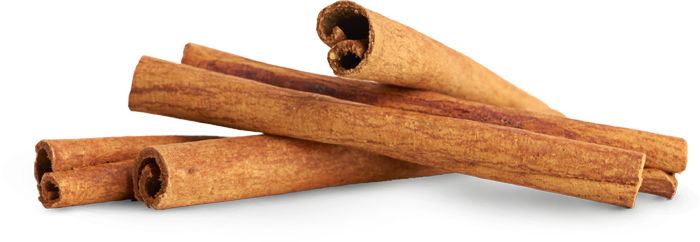הכינוי "קינמון" נגזר מהמילה הלטינית cannella (תעלה), המתייחסת לצורה שבה מסתלסלת פנימה קליפת העץ כאשר היא מתייבשת.
קינמון הינו עץ ירוק-עד קטן, ומוצאו בדרום-מזרח אסיה. קינמון משמש כתבלין נפוץ במטבח הביתי.
קינמון מותר לשיווק בישראל.

חלק הצמח בשימוש
קליפת הגזע.
איכויות
טמפרטורה: חם.
לחות: יבש.
טעם:מתוק, פיקנטי.
רכיבים פעילים עיקריים
שמן נדיף (עד 4%, הכולל בעיקר cinnamaldehyde), טאנינים, פרואנטוציאנידים, מונוטרפנים, ססקוויטרפנים, שרף, חומרים ריריים (מוצילאגים).
התוויות
סוכרת, שפעת, הצטננות, גזים, דיספפסיה.
מינונים
תמצית נוזלית בריכוז 1:3, 45% אלכוהול – 2-10 מ"ל ביום.
מרתח (הרתחה קצרה) – 2-5 גרם ביום
בפורמולה – 20%-30%.
רגישות
תגובה אלרגית לקינמון (בשכיחות נמוכה) עלולה להתבטא ב למידע השלם למנויים
תופעות לוואי ומינון יתר
לא ידועות תופעות לוואי.
לא ידוע על מינון יתר.
אזהרות וצעדי מנע
קינמון עלול לעורר (בשכיחות נמוכה) תגובה אלרגית; רצוי להתחיל את הטיפול למידע השלם למנויים
התוויות נגד
קינמון אסור לשימוש באנשים הסובלים מ למידע השלם למנויים
כמו כן, אין להשתמש בקינמון במצבים של למידע השלם למנויים
רעילות
לא נצפתה רעילות כלשהי בשימוש בקינמון במינונים הרפואיים המקובלים.
תגובות הדדיות עם תרופות / צמחי מרפא / תוספי תזונה
חילוף חומרים תרופתי – למידע השלם למנויים
סטטינים - למידע השלם למנויים
תרופות להורדת סוכר – למידע השלם למנויים
הריון
קינמון אפשרי לשימוש בהריון.
עם זאת, יש להימנע משימוש בכמויות גדולות של קינמון בתקופה זו(1,6,14-17), עקב למידע השלם למנויים
הנקה
אין מספיק מידע בנושא, ולכן מוטב שלא להשתמש בקינמון בתקופה זו(1,16,19).
מקורות
- Blumenthal M (ed.). Cinnamomi ceylanici cortex. The Complete German Commission E Monographs. Integrative Medicine Communications, Boston, Mass., 1998.
- Nixon R. Vignette in contact dermatology. Cinnamon allergy in bakers. Australian journal of dermatology, 1995, 36:41.
- Hausen BJM. Allergiepflanzen-Pflanzenallergene. Landsberg, Ecomed, 1988:95–96.
- Calnan CD. Cinnamon dermatitis from an ointment. Contact dermatitis, 1976, 2:167–170.
- Drake TE, Maibach HI. Allergic contact dermatitis and stomatitis caused by cinnamic aldehyde-flavored toothpaste. Archives of dermatology, 1976, 112:202–203.
- De Smet PAGM et al. (eds.). Adverse Effects of Herb Drugs 2. Springer-Verlag, Berlin, 1993
- Bisset NG. Max Wichtl’s herbal drugs & phytopharmaceuticals. Boca Raton, FL, CRC Press, 1994:148–150.
- Medicinal plants in China. Manila, World Health Organization, 1989:78–79 (WHO Regional Publications, Western Pacific Series, No. 2).
- Mills S, Bone K. Principles and Practice of Phytotherapy. Churchill Livingstone, Edinburg, 2000
- Sigmund CJ, McNally EF. The action of a carminative on the lower esophageal sphincter. Gastroenterol., 56:13-18, 1969
- Kimura Y, Ito H, Hatano T. Effects of mace and nutmeg on human cytochrome P450 3A4 and 2C9 activity. Biol Pharm Bull. 2010 ; 33(12): 1977
- Ranasinghe P, Katulanda P, et al. Efficacy and safety of 'true' cinnamon (Cinnamomum zeylanicum) as a pharmaceutical agent in diabetes: a systematic review and meta-analysis. Diabet Med. 2012 Dec; 29(12): 1480-92.
- Prabhakar PK, Doble M, et al. Mechanism of action of natural products used in the treatment of diabetes mellitus. Chin J Integr Med. 2011 Aug;17(8):563-74.
- Brinker F. The Toxicology of Botanical Medicines, 3rd ed. Eclectic Medical Pub., Sandy, Ore., 2000
- Wichtl M (ed.). Herbal Drugs and Phytopharmaceuticals. CRC Press, Boca Raton, 1994
- McGuffin M, Hobbs C, Upton R, Goldberg A (ed.). Botanical Safety Handbook. CRC Press, Boca Raton, 1997
- Gruenwald J, Brendler T, Jaenicke C (eds.). PDR for Herbal Medicines. Medical Economics Co., Inc., Montvale, NJ, 1998
- Farnsworth NR, Bingel AS, Cordell GA, et al. Potential value of plants as sources of new antifertility agents I. J. Pharm. Sci., 64:535-598, 1975
- WHO. Cortex Cinnamomi. WHO Monographs on Selected Medicinal Plants. 1 vol. Geneva: World Health Organization; 1999:95-104.
-
Brancheau D, Patel B, Zughaib M. Do cinnamon supplements cause acute hepatitis? Am J Case Rep. 2015 Apr 29;16:250-4.
- Gardner ZE, McGuffin M, American Herbal Products Association.: American herbal products association's botanical safety handbook, 2nd edn. Boca aton: American Herbal Products Association, CRC Press; 2013. Gunn TR, Wright IM: The use of black and blue cohosh in labour. N Z Med J 1996, 109(1032):410-411

